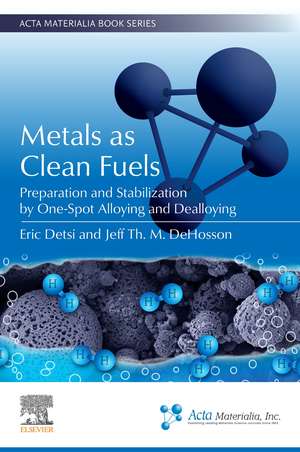Metals as Clean Fuels: Acta Materialia Book Series
Autor Eric Detsi, Jeff Th. M. DeHossonen Limba Engleză Paperback – iun 2025
After addressing the key questions and working principles in Chapters 1-3, the authors structured the content of the book by discussing metals at different ends of the energy density scale. In doing so, they examine zinc, which has a relatively low energy density, in Chapters 4 and 5. In contrast, they cover aluminum, situated at the high-density end, in Chapters 6 and 7. Next, the monograph further focuses on novel sustainable methods for fabricating metal/metal nanocomposites without the loss of sacrificial materials, as discussed in Chapters 8 and 9. This sustainable synthesis approach minimizes material loss during the dealloying process and creates new opportunities for developing metal/metal nanocomposites made from dissimilar nanoporous metal layers stacked together.
Finally, the book shows that, in addition to chemical composition and geometrical defects like interfaces, topology is an important design parameter. An inspiring methodology based on Integral-Geometry Morphological Image Analysis for porous material systems is presented, demonstrating that this method effectively analyzes geometrical objects and topological patterns in various porous systems in Chapter 10.
The monograph is the first of its kind to discuss state-of-the-art nanostructured metals as clean fuels. This timely book has the potential to catalyze and advance research in a field that lies at the intersection of various materials science disciplines. It aims to create highly versatile material systems for energy applications.
- Examines various methods of metal fuel activation through nanostructuring, i.e., creating nanoporous metal fuels through selective chemical and electrolytic dealloying
- Discusses a novel, versatile electrolytic method for making nanoporous metals that nearly eliminates the loss of sacrificial materials
- Includes the characterization of the fascinating intertwining of two different items in porous structures, i.e., geometry and topology. An integral-geometry based approach is presented demonstrating the simplicity of its practical application to porous systems
Preț: 1221.14 lei
Preț vechi: 1585.90 lei
-23% Nou
Puncte Express: 1832
Preț estimativ în valută:
233.70€ • 241.42$ • 194.49£
233.70€ • 241.42$ • 194.49£
Carte nepublicată încă
Doresc să fiu notificat când acest titlu va fi disponibil:
Se trimite...
Preluare comenzi: 021 569.72.76
Specificații
ISBN-13: 9780443135378
ISBN-10: 0443135371
Pagini: 420
Dimensiuni: 152 x 229 mm
Editura: ELSEVIER SCIENCE
Seria Acta Materialia Book Series
ISBN-10: 0443135371
Pagini: 420
Dimensiuni: 152 x 229 mm
Editura: ELSEVIER SCIENCE
Seria Acta Materialia Book Series
Cuprins
1. How Metal Fuels Work
2. Activation of Metal Fuels
3. Fundamentals of Dealloying
4. Monolithic Bulk Nanoporous Zinc by Free Corrosion Dealloying
5. Rapid Synthesis of Nanoporous Zinc in Powder Form by Free Corrosion Dealloying
6. Monolithic Bulk Nanoporous Aluminum by Air-Free Electrolytic Dealloying with Recovery of Sacrificial Materials
7. Rapid Synthesis of Nanoporous Aluminum Powder by Air-Free Electrolytic Dealloying with Recovery of Sacrificial Materials
8. Nanoporous tri-layer of similar elements by etching without sacrificing materials through the Kirkendall effect
9. Nanoporous tri-layer of dissimilar elements by etching without sacrificing materials through the Kirkendall effect
10. Porous structures and their geometric and topological characteristics
2. Activation of Metal Fuels
3. Fundamentals of Dealloying
4. Monolithic Bulk Nanoporous Zinc by Free Corrosion Dealloying
5. Rapid Synthesis of Nanoporous Zinc in Powder Form by Free Corrosion Dealloying
6. Monolithic Bulk Nanoporous Aluminum by Air-Free Electrolytic Dealloying with Recovery of Sacrificial Materials
7. Rapid Synthesis of Nanoporous Aluminum Powder by Air-Free Electrolytic Dealloying with Recovery of Sacrificial Materials
8. Nanoporous tri-layer of similar elements by etching without sacrificing materials through the Kirkendall effect
9. Nanoporous tri-layer of dissimilar elements by etching without sacrificing materials through the Kirkendall effect
10. Porous structures and their geometric and topological characteristics


